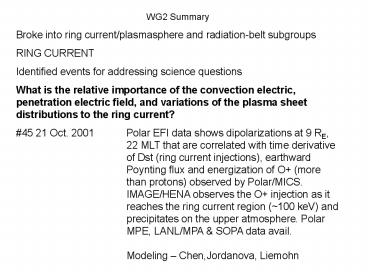WG2 Summary - PowerPoint PPT Presentation
1 / 6
Title:
WG2 Summary
Description:
45 21 Oct. 2001 Polar EFI data shows dipolarizations at 9 RE, 22 MLT that are ... and timing, needs further correlative, superposed epoch and event study. ... – PowerPoint PPT presentation
Number of Views:44
Avg rating:3.0/5.0
Title: WG2 Summary
1
WG2 Summary Broke into ring current/plasmasphere
and radiation-belt subgroups RING
CURRENT Identified events for addressing science
questions What is the relative importance of the
convection electric, penetration electric field,
and variations of the plasma sheet distributions
to the ring current? 45 21 Oct. 2001 Polar EFI
data shows dipolarizations at 9 RE, 22 MLT
that are correlated with time derivative of
Dst (ring current injections), earthward
Poynting flux and energization of O (more
than protons) observed by Polar/MICS.
IMAGE/HENA observes the O injection as it
reaches the ring current region (100 keV) and
precipitates on the upper atmosphere. Polar
MPE, LANL/MPA SOPA data avail. Modeling
Chen,Jordanova, Liemohn
2
The ring current causes large negative magnetic
field perturbations as well as enhancements in
fluxes of ions with 1-200 keV in the inner
magnetosphere yet these features have not been
simultaneously accounted for from in-situ
particle field and ENA observations. To what
extent are these observations consistent with
each other and with models within our current
framework of understanding of the ring current
based on transport and loss? 28-29 11-12 Aug
2000 Polar CAMMICE shows enhancements of H
fluxes during storm main phase. IMAGE/HENA
fluxes, Polar/MFE, LANL/MPA and SOPA
avail. Modeling Chen, Liemohn
3
PLASMASPHERE- Plan for Interchange
Investigation Goal Determine the what role (if
any) interchange, ballooning, and/or
Kelvin-Helmholtz instability might play in the
global evolution of the plasmasphere, especially
during erosion, formation of plumes, etc., but
also during quiet times. Method Use in situ
data to make concrete predictions for observable
features of instabilities in plasma. Try to
observe these features in EUV data. Data
Ionospheric data DMSP In situ equatorial (or
near equatorial) data Cluster CODIF remote
sensing equatorial IMAGE EUV Plan 1.
Identify conjunctions of Cluster in inner
magnetosphere (and CODIF measuring in RPA mode)
and IMAGE EUV. 2. identify events that have good
erosion in EUV. If good data in CODIF, proceed
to step 4. 3. If no good events in both CODIF and
EUV, broaden search to look at non erosion
times. 4. Get DMSP data for input to calculations
of Richardson number and predict, a. growth rate
of instability b.scale size, speed (and other
parameters) of observable features With
predictions for observable features of plasma,
look at EUV data.
4
RADIATION BELT Over what solar wind conditions
and L range is radial transport vs. localized
acceleration of electrons dominant? Empirical
models have been successful at predicting
geosynchronous fluxes based exclusively on input
solar wind parameters, assuming radial transport
as the dominant energization mechanism and
parameterized L, energy-dependent loss. ULF and
VLF wave power vs. L, correlated with electron
phase space density and solar wind conditions and
timing, needs further correlative, superposed
epoch and event study. How does the ring current
affect the radiation belt? WG1 WG4 overlap
48 24 Nov 2001 Check for overlap of ring
current 50-51 18-20 Apr 2002 plasmasphere
from HENA data high- energy e-
precipitation Study de-trapping of solar
energetic protons due to ring current during
(70) 20 Nov. 2003 storm (S. Youngs model)
5
WG2 Focused Event List 27 16 July 2000 Good
CAMMICE in im sq 5, WG3 overlap ULF wave data,
good LANL coverage,IMAGE 28-29 11-12 Aug
2000 Good CAMMICE in im, CEASE, HENA no SEP,
enhancement of energetic el, sq 6 33 29 Oct
2000 Good Polar/CAMMICE, HENA, EUV, sq 6 37
31 Mar 2001 Superstorm weak
RB, strong RC, WG3 overlap 45 21-23
Oct 2001 ENA, good Polar EFI 47 6 Nov
2001 CLUSTER in p.s., SEP trapping, rb model
results 48 24 Nov 2001 SEP
trapping, rb and ring current model
results 50-51 18-20 Apr 2002 Good CAMMICE in
p.s., EUV, HENA,
CLUSTER in i.m. in rec. phase sq 5, WG3
58-60 1 Oct 2002 Good CEASE, HENA, CLUSTER in
i.m. in
rec. phase no SEP, enhancement of
energetic el 68-69 30 Oct 2003
Good CEASE, EUV SEP, CLUSTER in
recovery
phase Superstorm, sq 5 WG3 overlap 70 20 Nov
2003 Good EUV, CLUSTER in ps largest Dst,
abrupt deep loss of energetic e-, sq 5, WG3
74-76 27 July 2004 Good CEASE, CLUSTER in ps
no SEP,G/HEO e- hi 78-79 08 Nov 2004
Good CEASE, EUV, G/HEO e- hi
6
Collectively agreed upon a table of key
geomagnetic data Maximum solar wind density
speed Shock arrival time IMF Bz, Btot Time
and value of peak Dst, Kp, PCI and sum Kp over
main phase Standoff distance to magnetopause
Start duration of main phase and storm Peak
AMIE Cross Polar Cap Potential Min L, L and
value of Max Counts/Flux of 2-MeV e- enhancement
Peak radiation belt content indices
Time-resolved electron dropouts at L 5
Electron Loss Index ULF Wave Activity Location
of plasmapause (day, min. average L of
plasmapause) Presence of Plume (Yes/No) EUV
witness erosion (No/Yes time) Average of
LANL/MPA density and temperature during PM main
and recovery phases Normalized integrated HENA
flux Inner edge of ring current from HENA
Sawtooth Oscillations (Yes/No)































